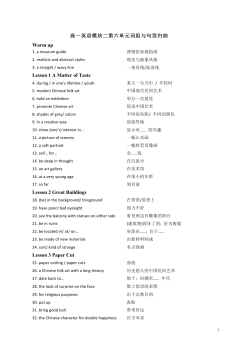
Low Carbon Cities in China, Serious Challenges and Signs of Hope
China Sustainability Project POLICY BRIEF SERIES Low Carbon Cities in China, Serious Challenges and Signs of Hope André Corrêa d'Almeida* and Travis Bradford** October 8, 2014 Our recent trip to China was designed to explore sustainability issues in several megacities. The continued growth of the world's largest and fastest growing economy is still apparent in cities from Shenzhen to Shanghai to Beijing, but we wanted to understand better the process by which this now-middle-income economy is working to make the turn to a more energy-efficient and environmentally sustainable system that is necessary to enable continued growth in wealth and prosperity. More specifically we wanted to capture the perceptions of local major actors politicians, city administrators, scholars, citizens, and international organizations - on these issues. This post is to a very large extent informed by both multiple conversations held with these development agents and many hours of discussions between the two of us. Despite the worst fears of impending environmental tragedy that arise from a reading of air quality data or the trajectory of coal use, China is walking a path that many cities and nations have walked before. London, Los Angeles, New York City, and Tokyo among many other places have also had periods of deeply disturbing environmental degradation and predictions of worse to come. Yet these cities today have some of the best environmental conditions they have enjoyed in decades, with plans in place to continue building on these gains (see Figure 1). Fig. 1: Air Pollution in London (1952) vs. Beijing (2013) Unfortunately, counter-examples also exist from Manila to Mexico City to Rio de Janeiro, where good intentions have failed to materialize. Therefore, China's urban environmental trajectory can be understood by examining * André Corrêa d’Almeida, PhD, is an Adjunct Professor at the School of International and Public Affairs and Program Director at the Earth Institute, Columbia University. ** Travis Bradford is an Associate Professor of Practice and the Director of the Energy and Environment Concentration at the School of International and Public Affairs, Columbia University. www.cgsd.columbia.edu/china China Sustainability Project what led to the trajectory changes in places like London, and whether China can replicate these circumstances in the years ahead. Chinese authorities are willing to introduce new measures as it is how fast and effectively will these be introduced. The good news is that the national conversation on these issues, repeated often at the 2nd Annual Shenzhen Sustainability Forum where we both spoke in June, is firmly positive on the potential to do so. This optimism is based on a combination of the messages being received from the Chinese Government saying that environmental factors are important aspects of overall development strategy and a deeply held conviction that anything the Chinese government wants it will achieve. It is true that China, much more so than most countries today, has the ability to provide the necessary certainty and rapidity to the investment in cleaner and sustainable technologies. Largely due to a strong central government and leadership, China suffers less from many types of policy uncertainty than more market-oriented economies, with very clear signaling leading to action and investment. In addition, deeper control over the banking sector and project finance allows for more targeted investment in desired technologies and industries, as well as very strict and clear prohibitions on activity and investment that is not. Witness the closure of roughly 2000 small coal-mining firms planned for 2014 as part of the Beijing's ongoing effort to reduce the alarming rates of air pollution. For instance, in 2013, the 3rd Plenary Session of 18th CPC Central Committee has confirmed that "building ecological civilization system" is a key aspect of China's social reform by 2020. The Committee stated "we must deepen ecological environment management reform by centering on building a beautiful China. We should accelerate system building to promote ecological progress, improve institutions and mechanisms for developing geographical space, conserving resources and protecting the ecological environment and promoting modernization featuring harmonious development between Man and Nature." One problem, however, is that even in best case-scenario impacts resulting from new environmental measures will take decades to materialize. For instance, the air quality in Los Angeles today is the result of a multi-decadal effort began from the nation's first urban air pollution control program in 1947. This program has undergone multiple major updates every decade. In London this process was initiated in 1954 with the introduction of smokeless zones and in 1956 with The Clean Air Act. So the critical question is not so much whether Conviction is important, though, in making the shift toward sustainable energy and environmental practices. In the LA and London examples this conviction arose from a broad recognition of the damage the pollution caused in health and economic terms, and strong pluralities formed and allowed for a public consensus to emerge on the need for improved outcomes. This public outcry is happening in China today, which the Chinese government is observing with rising anxiety, with a growing number of environmental protests signaling a galvanized public opinion. The frequency of protests is rising as China's increasingly affluent and middle-class society becomes more aware of environmental issues, and protests concerning incidents of environmental pollution in China have grown by an average of 29% every year. www.cgsd.columbia.edu/china 2 China Sustainability Project The number of environmental protests rose by 120% from 2010 to 2011, according to Yang Chaofei, the vice-chairman of the Chinese Society for Environmental Sciences. The government is responding with a slate of specific improvements. Since 2003, China has implemented a series of regulations and policies, including the Measures on Environmental Information Disclosure, promoting the release of environmental information and providing an important basis for public participation in the prevention of pollution. By 2010, the public pressure created by information disclosure has caused over 300 firms in breach of regulations to explain why the problems arose and the measures taken to resolve them. Beijing-Tianjin-Hebei was determined as China's "most polluted" region last year, and, among them, agreed to burn 63 million fewer tones of coal by 2017 than in 2012. Shanghai and its surrounding Yangtze River Delta, have claimed to reduce pm2.5 concentration by 20% in three years, through cutting coal consumption, promoting clean energy, encouraging lowcarbon transportation, enhancing regional environmental management, and strengthening political and technical support. the official statistics that tell an improving story. Coal use, coal imports, and the number of coalfired power plants operating in the country are all still rising and are expected by most forecasters to continue doing so. A short flight from Shanghai to Beijing was an anecdotal reality check on the situation, with the air quality issues having escaped the urban boundaries to now cover much of the costal region, and rivers choked with algae visible from the air. If China is going to turn the corner on these issues, much more work will have to be done. More technological fixes and investment are certainly needed, but additional accountability would help to ensure that the promises and good intentions of the current Central Government's response to public opinion leads to real improvement in the health and welfare outcomes that will make China a truly great power for a long time to come. And on April 24, 2014, Chinese legislators passed the first amendments to the country's environmental protection law in 25 years, setting environmental protection as the country's basic policy, promising greater powers for environmental authorities and harsher punishments for polluters. Unfortunately, beyond these stated goals, there is very little evidence that the trajectory of pollution and fossil fuel use is turning. Air quality measures of industrial pollutants, particulates, and smog are worsening, despite www.cgsd.columbia.edu/china 3
© Copyright 2025















